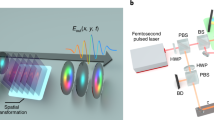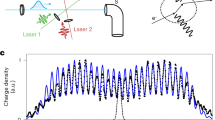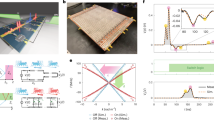Abstract
Coherent wave control exploits the interference among multiple waves impinging on a system to suppress or enhance outgoing signals based on their relative phase and amplitude. This process inherently requires the combination of energy exchanges among the waves and spatial interfaces to tailor their scattering. Here we explore the temporal analogue of this phenomenon, based on time interfaces that support instantaneous non-conservative scattering events for photons. Based on this mechanism, we demonstrate ultrabroadband temporal coherent wave control and the photonic analogue of mechanical collisions with phase-tunable elastic features. We apply them to erase, enhance and reshape arbitrary pulses by suitably tailoring the amplitude and phase of counterpropagating signals. Our findings provide a pathway to effectively sculpt broadband light with light without requiring spatial boundaries, within an ultrafast and low-energy platform.
This is a preview of subscription content, access via your institution
Access options
Access Nature and 54 other Nature Portfolio journals
Get Nature+, our best-value online-access subscription
$29.99 / 30 days
cancel any time
Subscribe to this journal
Receive 12 print issues and online access
$209.00 per year
only $17.42 per issue
Buy this article
- Purchase on Springer Link
- Instant access to full article PDF
Prices may be subject to local taxes which are calculated during checkout



Similar content being viewed by others
Data availability
Authors can confirm that all relevant data are included in the paper and/or its Supplementary Information files. Source data are provided with this paper. Where very large datasets were produced, source data are available upon request from the corresponding author.
Code availability
The code used to produce these results is available upon request from the corresponding author.
References
Chong, Y. D., Ge, L., Cao, H. & Stone, A. D. Coherent perfect absorbers: time-reversed lasers. Phys. Rev. Lett. 105, 053901 (2010).
Wan, W. et al. Time-reversed lasing and interferometric control of absorption. Science 331, 889–892 (2011).
Bacot, V., Labousse, M., Eddi, A., Fink, M. & Fort, E. Time reversal and holography with spacetime transformations. Nat. Phys. 12, 972–977 (2016).
Moussa, H. et al. Observation of temporal reflections and broadband frequency translations at photonic time-interfaces. Nat. Phys. 19, 863–868 (2023).
Morgenthaler, F. R. Velocity modulation of electromagnetic waves. IRE Trans. Microw. Theory Tech. 6, 167–172 (1958).
Galiffi, E. et al. Photonics of time-varying media. Adv. Photonics 4, 014002 (2022).
Yin, S., Galiffi, E. & Alù, A. Floquet metamaterials. eLight 2, 1–13 (2022).
Engheta, N. Metamaterials with high degrees of freedom: space, time, and more. Nanophotonics 10, 639–642 (2020).
Lyubarov, M. et al. Amplified emission and lasing in photonic time crystals. Science 377, 425–428 (2020).
Estep, N. A., Sounas, D. L., Soric, J. & Alù, A. Magnetic-free non-reciprocity and isolation based on parametrically modulated coupled-resonator loops. Nat. Phys. 10, 923–927 (2014).
Lira, H., Yu, Z., Fan, S. & Lipson, M. Electrically driven nonreciprocity induced by interband photonic transition on a silicon chip. Phys. Rev. Lett. 109, 033901 (2012).
Yu, Z. & Fan, S. Complete optical isolation created by indirect interband photonic transitions. Nat. Photonics 3, 91–94 (2009).
Galiffi, E., Huidobro, P. A. & Pendry, J. B. Broadband nonreciprocal amplification in luminal metamaterials. Phys. Rev. Lett. 123, 206101 (2019).
Cromb, M. et al. Amplification of waves from a rotating body. Nat. Phys. 16, 1069–1073 (2020).
Huidobro, P. A., Galiffi, E., Guenneau, S., Craster, R. V. & Pendry, J. B. Fresnel drag in space–time-modulated metamaterials. Proc. Natl Acad. Sci. USA 116, 24943–24948 (2019).
Zhou, Y. et al. Broadband frequency translation through time refraction in an epsilon-near-zero material. Nat. Commun. 11, 1–7 (2020).
Bohn, J., Luk, T. S., Horsley, S. & Hendry, E. Spatiotemporal refraction of light in an epsilon-near-zero indium tin oxide layer: frequency shifting effects arising from interfaces. Optica 8, 1532–1537 (2021).
Tirole, R. et al. Double-slit time diffraction at optical frequencies. Nat. Phys. 1–4 (2023).
Moshinsky, M. Diffraction in time. Phys. Rev. 88, 625 (1952).
Apffel, B., Wildeman, S., Eddi, A. & Fort, E. Experimental implementation of wave propagation in disordered time-varying media. Phys. Rev. Lett. 128, 094503 (2022).
Carminati, R., Chen, H., Pierrat, R. & Shapiro, B. Universal statistics of waves in a random time-varying medium. Phys. Rev. Lett. 127, 094101 (2021).
Sharabi, Y., Lustig, E. & Segev, M. Disordered photonic time crystals. Phys. Rev. Lett. 126, 163902 (2021).
Fleury, R., Khanikaev, A. B. & Alù, A. Floquet topological insulators for sound. Nat. Commun. 7, 1–11 (2016).
Darabi, A., Ni, X., Leamy, M. & Alù, A. Reconfigurable Floquet elastodynamic topological insulator based on synthetic angular momentum bias. Sci. Adv. 6, eaba8656 (2020).
Lustig, E., Sharabi, Y. & Segev, M. Topological aspects of photonic time crystals. Optica 5, 1390–1395 (2018).
Wang, K., Dutt, A., Wojcik, C. C. & Fan, S. Topological complex-energy braiding of non-Hermitian bands. Nature 598, 59–64 (2021).
Dutt, A. et al. A single photonic cavity with two independent physical synthetic dimensions. Science 367, 59–64 (2020).
Li, H., Yin, S., Galiffi, E. & Alù, A. Temporal parity-time symmetry for extreme energy transformations. Phys. Rev. Lett. 127, 153903 (2021).
Pacheco-Peña, V. & Engheta, N. Antireflection temporal coatings. Optica 7, 323–331 (2020).
Pacheco-Peña, V. & Engheta, N. Temporal aiming. Light: Sci. Appl. 9, 1–12 (2020).
Mosk, A. P., Lagendijk, A., Lerosey, G. & Fink, M. Controlling waves in space and time for imaging and focusing in complex media. Nat. Photonics 6, 283–292 (2016).
Pendry, J. B. Time reversal and negative refraction. Science 322, 71–73 (2008).
Vezzoli, S. et al. Optical time reversal from time-dependent epsilon-near-zero media. Phys. Rev. Lett. 120, 043902 (2018).
Lerosey, G., De Rosny, J., Tourin, A. & Fink, M. Focusing beyond the diffraction limit with far-field time reversal. Science 315, 1120–1122 (2007).
Galiffi, E., Yin S. & Alù, A. Tapered photonic switching. Nanophotonics 11, 3575–3581 (2022).
Roger, T. et al. Coherent perfect absorption in deeply subwavelength films in the single-photon regime. Nat. Commun. 6, 1–5 (2015).
Solís, D. M., Kastner, R. & Engheta, N. Time-varying materials in the presence of dispersion: plane-wave propagation in a Lorentzian medium with temporal discontinuity. Photonics Res. 9, 1842–1853 (2021).
Liberal, I., Vázquez-Lozano, J. E. & Pachecho-Peña, V. Quantum antireflection temporal coatings: quantum state frequency shifting and inhibited thermal noise amplification. Preprint at https://doi.org/10.48550/arXiv.2208.10089 (2022).
Reck, P. et al. Dirac quantum time mirror. Phys. Rev. B 95, 165421 (2017).
Kitagawa, T., Berg, E., Rudner, M. & Demler, E. Topological characterization of periodically driven quantum systems. Phys. Rev. B 82, 235114 (2010).
Mi, X. et al. Time-crystalline eigenstate order on a quantum processor. Nature 601, 531–536 (2022).
Ono, M. et al. Ultrafast and energy-efficient all-optical switching with graphene-loaded deep-subwavelength plasmonic waveguides. Nat. Photonics 14, 37–43 (2020).
Nishida, A. et al. Experimental observation of frequency up-conversion by flash ionization. Appl. Phys. Lett. 101, 161118 (2012).
Alam, M. Z., De Leon, I. & Boyd, R. W. Large optical nonlinearity of indium tin oxide in its epsilon-near-zero region. Science 352, 795–797 (2016).
Acknowledgements
This work was supported by the Air Force Office of Scientific Research, the CHARM programme and the Simons Foundation. E.G. was supported by the Simons Foundation through a Junior Fellowship of the Simons Society of Fellows (no. 855344).
Author information
Authors and Affiliations
Contributions
E.G. conceived the project, with contribution from A.A., and performed theoretical analysis. G.X. designed the experiments, performed measurements and interpreted the data. S.Y. performed numerical simulations. E.G. led the writing of the manuscript with contributions from all authors. A.A. supervised the project.
Corresponding author
Ethics declarations
Competing interests
The authors declare no competing interests.
Peer review
Peer review information
Nature Physics thanks Simon Horsley and the other, anonymous, reviewer(s) for their contribution to the peer review of this work.
Additional information
Publisher’s note Springer Nature remains neutral with regard to jurisdictional claims in published maps and institutional affiliations.
Extended data
Extended Data Fig. 1 Experimental setup for TI-enabled coherent wave control and photonic collisions.
(a) A photo of the fabricated TLM sample. (b) A simplified schematic for the measurement setup. A signal and an idler pulse are launched into the TLM from its two ports from an arbitrary waveform generator (AWG). The AWG is triggered by an external clock from a high voltage function generator. The clock is phase-locked to a control signal, sent by the same function generator to control the TLM switches. The phase between the clock and the control determines the spatial coherence between the signal and the idler at the instant of collision. The time evolution of voltages at both ports is monitored using a sampling oscilloscope.
Extended Data Fig. 2 Measured scattering parameters of the T-connectors.
Note that the frequency regime of interest is essentially dispersionless. The transmission coefficient between any two ports has a constant amplitude of −3.5 dB. As it is passive and reciprocal, the T-connector cannot be perfectly matched at all ports. This explains the −9.5 dB reflection seen from all ports despite the 50Ω termination. However, in a time domain measurement, any spuriously reflected signals due to impedance mismatch can be eliminated through time-gating.
Extended Data Fig. 3
Time-interface-enabled collision of modulated wave packets. Measurement of TI-enabled destructive (a,b) and constructive (c,d) collisions between Gaussian wave packets. (a) Complete annihilation (maximally destructive collision) of the signal using an idler with the same polarity and perfectly timed switching. The dashed green line corresponds to the case where no idler is present, and the signal experiences no collision. (b) If no switching occurs, the signal and the idler wave packets do not interact and simply pass through each other. As they reach the opposite port, some spatial reflection occurs due to the impedance mismatch introduced by the T-connector, which causes visible ‘echoes’ from the ends of the line at times t>150ns. Although these spatial reflections also occur in panel A, they are hardly visible due to the increased loss and dispersion in the ‘SWITCH ON’ configuration of our TLM, which causes increased pulse attenuation and broadening. (c) Constructive collision with the signal using an idler with opposite polarity. The resulting signal amplitude is approximately doubled compared to the output in the absence of idler. (d) Again, in the absence of switching, the signal and the idler do not collide and cannot exchange energy.
Supplementary information
Supplementary Note
Supplementary Sections 1–4.
Source data
Source Data Fig. 2
Unprocessed oscilloscope measurements.
Source Data Fig. 2
Unprocessed oscilloscope measurements.
Source Data Fig. 2
Unprocessed oscilloscope measurements.
Source Data Fig. 2
Unprocessed oscilloscope measurements.
Source Data Fig. 3
Finite-difference time-domain simulations.
Source Data Fig 3
Unprocessed oscilloscope measurements.
Source Data Extended Data Fig. 2
Vector network analyzer measurement for the T-connector.
Source Data Extended Data Fig. 3
Unprocessed oscilloscope measurements.
Source Data Extended Data Fig. 3
Unprocessed oscilloscope measurements.
Source Data Extended Data Fig. 3
Unprocessed oscilloscope measurements.
Source Data Extended Data Fig. 3
Unprocessed oscilloscope measurements.
Source Data Extended Data Fig. 3
Unprocessed oscilloscope measurements.
Source Data Extended Data Fig. 3
Unprocessed oscilloscope measurements.
Rights and permissions
Springer Nature or its licensor (e.g. a society or other partner) holds exclusive rights to this article under a publishing agreement with the author(s) or other rightsholder(s); author self-archiving of the accepted manuscript version of this article is solely governed by the terms of such publishing agreement and applicable law.
About this article
Cite this article
Galiffi, E., Xu, G., Yin, S. et al. Broadband coherent wave control through photonic collisions at time interfaces. Nat. Phys. 19, 1703–1708 (2023). https://doi.org/10.1038/s41567-023-02165-6
Received:
Accepted:
Published:
Issue Date:
DOI: https://doi.org/10.1038/s41567-023-02165-6
This article is cited by
-
Time interfaces for broadband coherent wave manipulation
Nature Physics (2023)



